倒装句型
- 格式:doc
- 大小:29.00 KB
- 文档页数:3
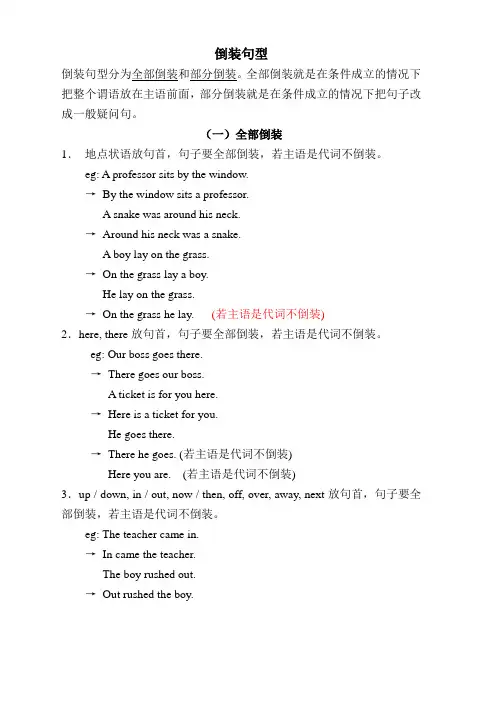
倒装句型倒装句型分为全部倒装和部分倒装。
全部倒装就是在条件成立的情况下把整个谓语放在主语前面,部分倒装就是在条件成立的情况下把句子改成一般疑问句。
(一)全部倒装1.地点状语放句首,句子要全部倒装,若主语是代词不倒装。
eg: A professor sits by the window.→By the window sits a professor.A snake was around his neck.→Around his neck was a snake.A boy lay on the grass.→On the grass lay a boy.He lay on the grass.→On the grass he lay. (若主语是代词不倒装)2.here, there放句首,句子要全部倒装,若主语是代词不倒装。
eg: Our boss goes there.→There goes our boss.A ticket is for you here.→Here is a ticket for you.He goes there.→There he goes. (若主语是代词不倒装)Here you are. (若主语是代词不倒装)3.up / down, in / out, now / then, off, over, away, next放句首,句子要全部倒装,若主语是代词不倒装。
eg: The teacher came in.→In came the teacher.The boy rushed out.→Out rushed the boy.The car went away.→Away went the car.He jumped up with joy.→Up he jumped with joy. (若主语是代词不倒装)4.作表语的形容词、现在分词、过去分词放句首,句子要全部倒装,若主语是代词不倒装。
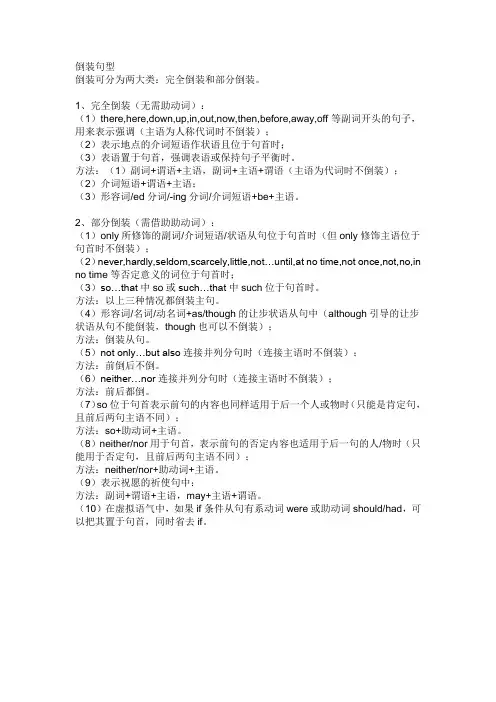
倒装句型倒装可分为两大类:完全倒装和部分倒装。
1、完全倒装(无需助动词):(1)there,here,down,up,in,out,now,then,before,away,off等副词开头的句子,用来表示强调(主语为人称代词时不倒装);(2)表示地点的介词短语作状语且位于句首时;(3)表语置于句首,强调表语或保持句子平衡时。
方法:(1)副词+谓语+主语,副词+主语+谓语(主语为代词时不倒装);(2)介词短语+谓语+主语;(3)形容词/ed分词/-ing分词/介词短语+be+主语。
2、部分倒装(需借助助动词):(1)only所修饰的副词/介词短语/状语从句位于句首时(但only修饰主语位于句首时不倒装);(2)never,hardly,seldom,scarcely,little,not…until,at no time,not once,not,no,in no time等否定意义的词位于句首时;(3)so…that中so或such…that中such位于句首时。
方法:以上三种情况都倒装主句。
(4)形容词/名词/动名词+as/though的让步状语从句中(although引导的让步状语从句不能倒装,though也可以不倒装);方法:倒装从句。
(5)not only…but also连接并列分句时(连接主语时不倒装);方法:前倒后不倒。
(6)neither…nor连接并列分句时(连接主语时不倒装);方法:前后都倒。
(7)so位于句首表示前句的内容也同样适用于后一个人或物时(只能是肯定句,且前后两句主语不同);方法:so+助动词+主语。
(8)neither/nor用于句首,表示前句的否定内容也适用于后一句的人/物时(只能用于否定句,且前后两句主语不同);方法:neither/nor+助动词+主语。
(9)表示祝愿的祈使句中:方法:副词+谓语+主语,may+主语+谓语。
(10)在虚拟语气中,如果if条件从句有系动词were或助动词should/had,可以把其置于句首,同时省去if。
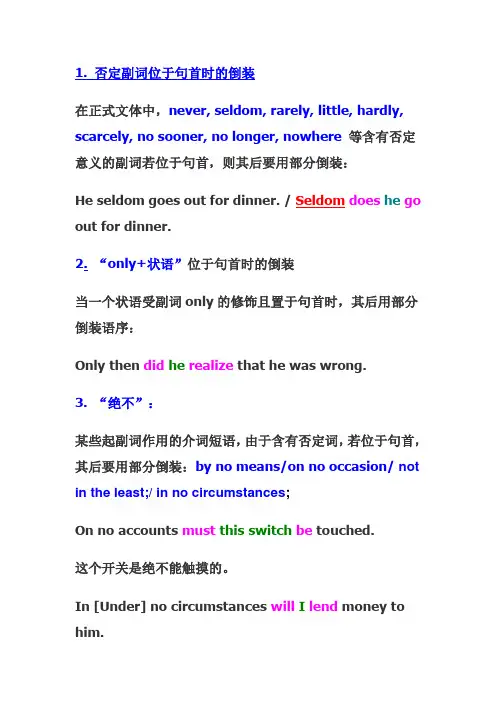
1. 否定副词位于句首时的倒装在正式文体中,never, seldom, rarely, little, hardly, scarcely, no sooner, no longer, nowhere 等含有否定意义的副词若位于句首,则其后要用部分倒装:He seldom goes out for dinner. / Seldom does he go out for dinner.2. “only+状语”位于句首时的倒装当一个状语受副词only的修饰且置于句首时,其后用部分倒装语序:Only then did he realize that he was wrong.3. “绝不”:某些起副词作用的介词短语,由于含有否定词,若位于句首,其后要用部分倒装:by no means/on no occasion/ not in the least;/ in no circumstances;On no accounts must this switch be touched.这个开关是绝不能触摸的。
In [Under] no circumstances will I lend money to him.无论如何我也不会再借钱给他了。
4.固定搭配:(1) 对于not…until句型,当not until…位于句首时,其后的主句要用倒装语序:He didn’t leave the room until the rain stopped. / Not until the rain stopped did he leave the room. 雨停了之后他才离开这房间。
(2) “前倒后不倒型”①由not only…but also引出的倒装当not only…but also位于句首引出句子时,not only 后的句子通常用部分倒装:Not only did he refuse the gift, he also severely criticized the sender.②表示“刚……就……的倒装结构no sooner…than, hardly… when,scarcely… whenHardly had he started to leave when it began to rain.他刚要离开,天就下起了雨。
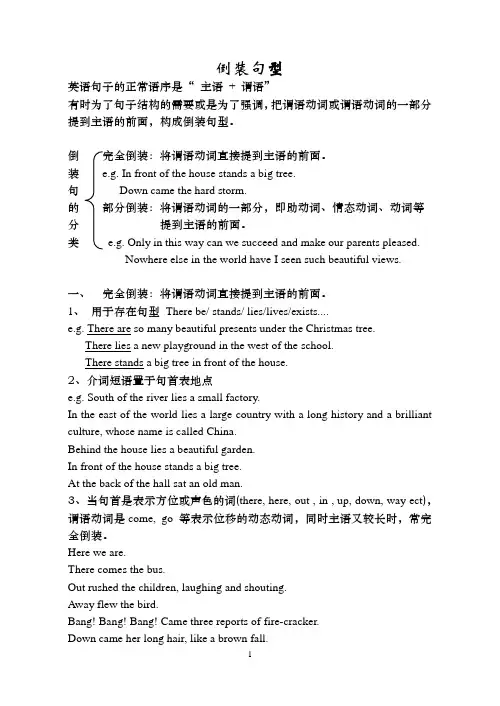
倒装句型英语句子的正常语序是“主语+ 谓语”有时为了句子结构的需要或是为了强调,把谓语动词或谓语动词的一部分提到主语的前面,构成倒装句型。
倒完全倒装:将谓语动词直接提到主语的前面。
装 e.g. In front of the house stands a big tree.句Down came the hard storm.的部分倒装:将谓语动词的一部分,即助动词、情态动词、动词等分提到主语的前面。
类 e.g. Only in this way can we succeed and make our parents pleased.Nowhere else in the world have I seen such beautiful views.一、完全倒装:将谓语动词直接提到主语的前面。
1、用于存在句型There be/ stands/ lies/lives/exists....e.g. There are so many beautiful presents under the Christmas tree.There lies a new playground in the west of the school.There stands a big tree in front of the house.2、介词短语置于句首表地点e.g. South of the river lies a small factory.In the east of the world lies a large country with a long history and a brilliant culture, whose name is called China.Behind the house lies a beautiful garden.In front of the house stands a big tree.At the back of the hall sat an old man.3、当句首是表示方位或声色的词(there, here, out , in , up, down, way ect),谓语动词是come, go等表示位移的动态动词,同时主语又较长时,常完全倒装。
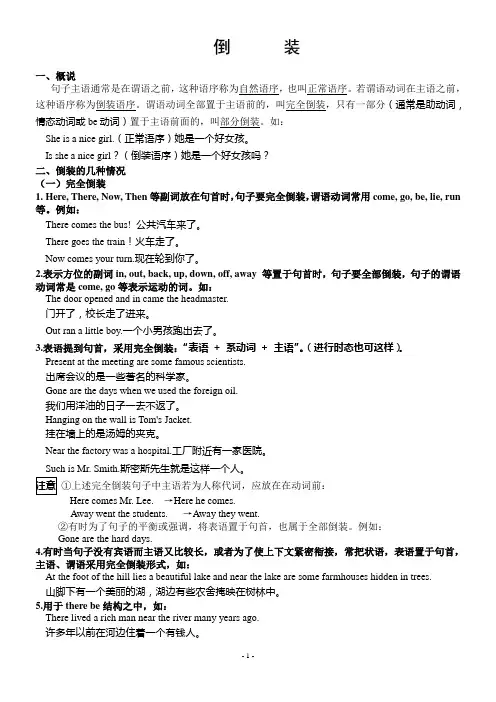
倒装一、概说句子主语通常是在谓语之前,这种语序称为自然语序,也叫正常语序。
若谓语动词在主语之前,这种语序称为倒装语序。
谓语动词全部置于主语前的,叫完全倒装,只有一部分(通常是助动词,情态动词或be动词)置于主语前面的,叫部分倒装。
如:She is a nice girl.(正常语序)她是一个好女孩。
Is she a nice girl?(倒装语序)她是一个好女孩吗?二、倒装的几种情况(一)完全倒装1. Here, There, Now, Then等副词放在句首时,句子要完全倒装,谓语动词常用come, go, be, lie, run 等。
例如:There comes the bus! 公共汽车来了。
There goes the train!火车走了。
Now comes your turn.现在轮到你了。
2.表示方位的副词in, out, back, up, down, off, away 等置于句首时,句子要全部倒装,句子的谓语动词常是come, go等表示运动的词。
如:The door opened and in came the headmaster.门开了,校长走了进来。
Out ran a little boy.一个小男孩跑出去了。
3.表语提到句首,采用完全倒装:“表语 + 系动词 + 主语”。
(进行时态也可这样)。
Present at the meeting are some famous scientists.出席会议的是一些著名的科学家。
Gone are the days when we used the foreign oil.我们用洋油的日子一去不返了。
Hanging on the wall is Tom's Jacket.挂在墙上的是汤姆的夹克。
Near the factory was a hospital.工厂附近有一家医院。
斯密斯先生就是这样一个人。
①上述完全倒装句子中主语若为人称代词,应放在在动词前:Here comes Mr. Lee. →Here he comes.Away went the students. →Away they went.②有时为了句子的平衡或强调,将表语置于句首,也属于全部倒装。
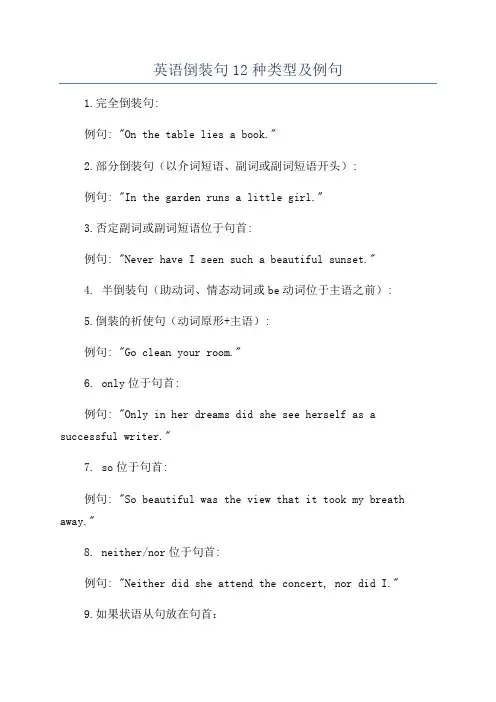
英语倒装句12种类型及例句1.完全倒装句:例句: "On the table lies a book."2.部分倒装句(以介词短语、副词或副词短语开头):例句: "In the garden runs a little girl."3.否定副词或副词短语位于句首:例句: "Never have I seen such a beautiful sunset."4. 半倒装句(助动词、情态动词或be动词位于主语之前):5.倒装的祈使句(动词原形+主语):例句: "Go clean your room."6. only位于句首:例句: "Only in her dreams did she see herself as a successful writer."7. so位于句首:例句: "So beautiful was the view that it took my breath away."8. neither/nor位于句首:例句: "Neither did she attend the concert, nor did I."9.如果状语从句放在句首:10.条件从句位于句首:例句: "Should he fail the exam, he will have to retake the course."11.介词短语或副词短语位于句首:例句: "In the corner sat a small dog."12. or/ nor引导的短语或句子位于句首:。
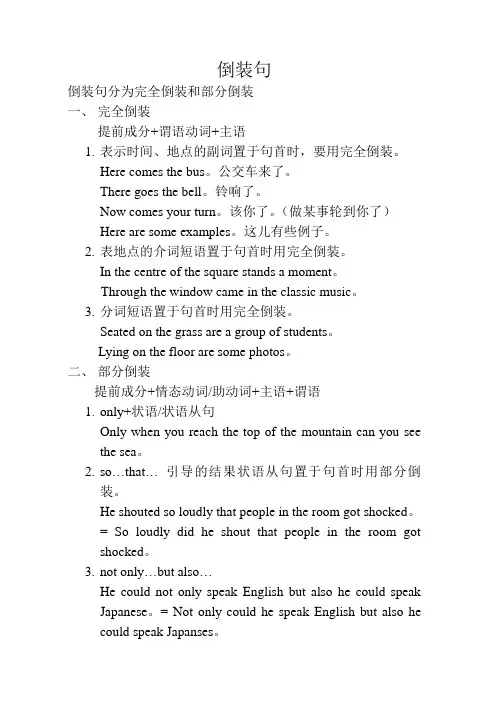
倒装句倒装句分为完全倒装和部分倒装一、完全倒装提前成分+谓语动词+主语1.表示时间、地点的副词置于句首时,要用完全倒装。
Here comes the bus。
公交车来了。
There goes the bell。
铃响了。
Now comes your turn。
该你了。
(做某事轮到你了)Here are some examples。
这儿有些例子。
2.表地点的介词短语置于句首时用完全倒装。
In the centre of the square stands a moment。
Through the window came in the classic music。
3.分词短语置于句首时用完全倒装。
Seated on the grass are a group of students。
Lying on the floor are some photos。
二、部分倒装提前成分+情态动词/助动词+主语+谓语1.only+状语/状语从句Only when you reach the top of the mountain can you see the sea。
2.so…that…引导的结果状语从句置于句首时用部分倒装。
He shouted so loudly that people in the room got shocked。
= So loudly did he shout that people in the room got shocked。
3.not only…but also…He could not only speak English but also he could speak Japanese。
= Not only could he speak English but also he could speak Japanses。
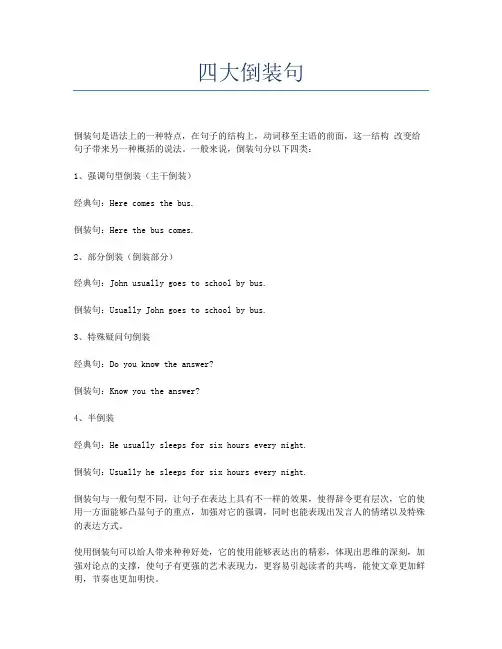
四大倒装句倒装句是语法上的一种特点,在句子的结构上,动词移至主语的前面,这一结构改变给句子带来另一种概括的说法。
一般来说,倒装句分以下四类:1、强调句型倒装(主干倒装)经典句:Here comes the bus.倒装句:Here the bus comes.2、部分倒装(倒装部分)经典句:John usually goes to school by bus.倒装句:Usually John goes to school by bus.3、特殊疑问句倒装经典句:Do you know the answer?倒装句:Know you the answer?4、半倒装经典句:He usually sleeps for six hours every night.倒装句:Usually he sleeps for six hours every night.倒装句与一般句型不同,让句子在表达上具有不一样的效果,使得辞令更有层次,它的使用一方面能够凸显句子的重点,加强对它的强调,同时也能表现出发言人的情绪以及特殊的表达方式。
使用倒装句可以给人带来种种好处,它的使用能够表达出的精彩,体现出思维的深刻,加强对论点的支撑,使句子有更强的艺术表现力,更容易引起读者的共鸣,能使文章更加鲜明,节奏也更加明快。
但倒装句使用时,需要特别注意这几点:首先,掌握正确的倒装方式,如部分倒装形式中只能倒装谓语动词的非第一个动词;其次,不能频繁使用(有的人因为喜欢使用而被误解为在投机取巧,而影响到句子的逻辑性,而且使句子不易理解);最后,要学会结合实际使用,使得倒装句更富有艺术性,触达读者心弦。
总而言之,倒装句是一种复杂的语法知识,掌握倒装句的使用方法及注意事项,可以给文字表达带来更多的丰富和新颖,也能帮助我们更好的驾驭文字表达。
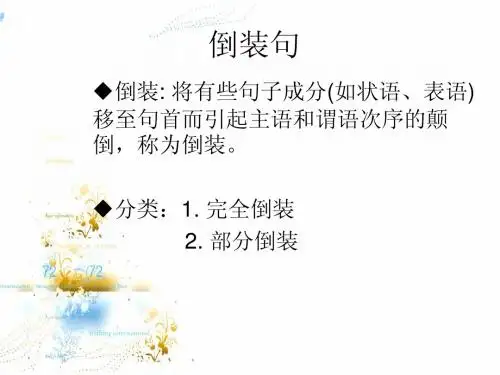

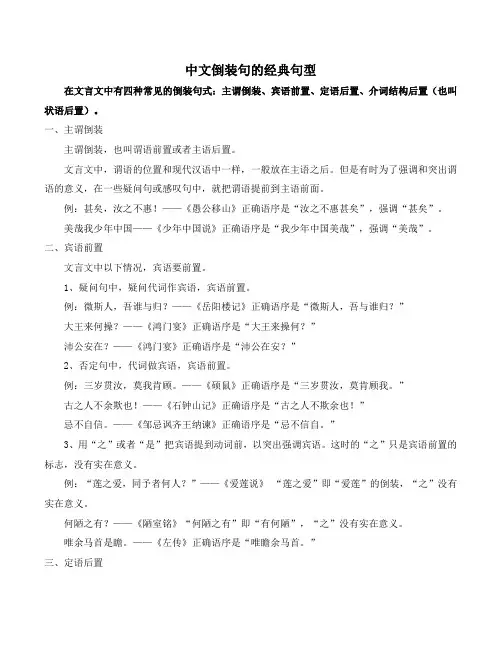
中文倒装句的经典句型在文言文中有四种常见的倒装句式:主谓倒装、宾语前置、定语后置、介词结构后置(也叫状语后置)。
一、主谓倒装主谓倒装,也叫谓语前置或者主语后置。
文言文中,谓语的位置和现代汉语中一样,一般放在主语之后。
但是有时为了强调和突出谓语的意义,在一些疑问句或感叹句中,就把谓语提前到主语前面。
例:甚矣,汝之不惠!——《愚公移山》正确语序是“汝之不惠甚矣”,强调“甚矣”。
美哉我少年中国——《少年中国说》正确语序是“我少年中国美哉”,强调“美哉”。
二、宾语前置文言文中以下情况,宾语要前置。
1、疑问句中,疑问代词作宾语,宾语前置。
例:微斯人,吾谁与归?——《岳阳楼记》正确语序是“微斯人,吾与谁归?”大王来何操?——《鸿门宴》正确语序是“大王来操何?”沛公安在?——《鸿门宴》正确语序是“沛公在安?”2、否定句中,代词做宾语,宾语前置。
例:三岁贯汝,莫我肯顾。
——《硕鼠》正确语序是“三岁贯汝,莫肯顾我。
”古之人不余欺也!——《石钟山记》正确语序是“古之人不欺余也!”忌不自信。
——《邹忌讽齐王纳谏》正确语序是“忌不信自。
”3、用“之”或者“是”把宾语提到动词前,以突出强调宾语。
这时的“之”只是宾语前置的标志,没有实在意义。
例:“莲之爱,同予者何人?”——《爱莲说》“莲之爱”即“爱莲”的倒装,“之”没有实在意义。
何陋之有?——《陋室铭》“何陋之有”即“有何陋”,“之”没有实在意义。
唯余马首是瞻。
——《左传》正确语序是“唯瞻余马首。
”三、定语后置文言文中,定语的位置一般也在中心词前边。
但有时为了突出中心词的地位,强调定语所表现的内容,或使语气流畅,往往把定语放在中心词之后。
例:其两膝相比者。
——《核舟记》正确语序是“其相比两膝者。
”盖简桃核修狭者为之。
——《核舟记》正确语序是“盖简修狭桃核者为之。
”居庙堂之高则忧其民,处江湖之远则忧其君。
——《岳阳楼记》“居庙堂之高”即“居高庙堂”,“处江湖之远”即“处远江湖”。
倒装句的种类及常见句型倒装句是英语中常见的一种语法结构,它与普通的句式结构不同,通常会将主语和谓语的顺序颠倒。
倒装句在表达强调、对比、条件等意义时具有独特的作用,同时也是考试和日常写作中需要掌握的重要语法知识。
本文将介绍倒装句的种类及常见句型。
一、完全倒装句完全倒装句在句子中把整个谓语都移至主语之前,常见的结构有以下几种:1. 在助动词或情态动词之前倒装:Never had I seen such a beautiful sunset before.(我以前从未见过如此美丽的日落。
)Not only does she speak English fluently, but she also speaks French.(她不仅英语讲得流利,而且还会说法语。
)2. 在表示方位、地点或副词(adverbs of place)之前倒装:Out rushed the students as soon as the bell rang.(铃一响,学生们都冲了出去。
)Here comes the bus.(车来了。
)3. 在表示条件和让步的状语从句之前倒装:Should you have any questions, please feel free to ask.(如果你有任何问题,请随时提问。
)However hard he worked, he couldn't pass the exam.(无论他多努力,他都无法通过考试。
)二、部分倒装句部分倒装句是指将谓语的一部分与主语颠倒,常见的结构有以下几种:1. 在否定副词或短语之前倒装:Not until midnight did the party finally come to an end.(直到午夜,聚会才最终结束。
)At no time did she mention his name.(她从不提他的名字。
)2. 在连词so、neither、nor等之后倒装:They were tired, and so were we.(他们累了,我们也是。
倒装句型知识点总结一、什么是倒装句型倒装句是指将句子中的谓语动词提前放置,主语放在动词之后的一种句型。
倒装句型分为部分倒装和全部倒装。
二、全部倒装1. 在以 here, there, out, in, off 等表示方向或位置的副词和介词短语开头的句子中,可用全部倒装的结构。
例句:Here comes the bus.译文:公共汽车来了。
2. 在以表示“否定”和“否定意义”的状语,即 never, seldom, little, in no way, not, rarely, scarcely, hardly 等副词开头的句子中,也可用全部倒装的结构。
例句:Seldom does he go to the cinema.译文:他很少去看电影。
3. 如果表示“地点的副词+助动词+主语”的句子,助动词提前,则采用全部倒装。
例句:On the wall hangs a picture.译文:墙上挂着一幅画。
4. 句首为否定副词或表否定意义的短语时,可用全部倒装的结构。
例句:Not until the war was over did he return home.译文:直到战争结束他才回家。
5. 表示“从句+主句”的倒装结构。
例句:However hard he worked, he could not pass the exam.译文:无论他多努力,他也没有通过考试。
三、部分倒装部分倒装是指在句首用助动词将主语与谓语的一部分倒装。
1. 在以 only, little, no sooner, hardly, scarcely 等副词开头的句子中,主、谓倒装。
例句:Only in this way can we succeed.译文:只有这样,我们才能成功。
2. 在以表示“基本上否定意义的频度词、程度副词或时间状语”如 seldom, never, not, hardly, nowhere, little, no more, at no time, by no means, in no way, in no circumstances, on no occasion, in no sense, under no conditions, under no circumstances, barely, seldom, little, rarely 等开头的句子中,主、谓倒装。
文言文中常见的四种倒装句式包括:主谓倒装、状语倒装、宾语倒装和动补倒装。
以下是每种倒装句式及例句:
1. 主谓倒装:
a. 谓语提前,主语后置。
b. 例句:飞花逐水容易别,落絮无情不觉春。
2. 状语倒装:
a. 状语或状语从句位于句首,谓语紧随其后。
b. 例句:春风得意马蹄疾,一日看尽长安花。
3. 宾语倒装:
a. 宾语位于句首,谓语紧随其后。
b. 例句:云想衣裳花想容,春风拂槛露华浓。
4. 动补倒装:
a. 动词+补语的结构中,补语位于句首,动词紧随其后。
b. 例句:不见此花人自寻,只闻寒雁叫西风。
这些例句中展示了不同的倒装句式,在文言文中常用于修辞或突出特定的表达方式。
请注意,这里的例句仅供参考,实际应用时可能根据语境和内容的需要进行变化。
倒装句(主倒,从不倒)(一)全倒装:1,句型there be(有) + 某物(主语) +在某处(介词短语);2,表语(形容词/过去分词/介词短语)+Be+主语3,用于“here(there, now, then, out, up, in, down, away etc) + vi +S(主语)以表示强调;Here comes the bus. Away hurried the man. 但代词作主语,主谓语序不变。
Away he hurried.4,表示地点的介词词组作状语在句首时+vi +S(主语);5,So/Nor/Neither/+助动词/系动词/情态动词+主语(也可+与前句不同的另外谓语动词)两个不同动词的句子用so it is / was with sb.= it is/was the same with sb.(So+主语+谓语:"的确如此")6,为了保持句子平衡,或强调使上下文紧密衔接时;They arrived at a farmhouse, in front of which sat a small boy。
(二)半倒装:1,as表示“尽管”引导让步状语从句:名词(无冠词)/形容词/副词/动词+as+主语+谓语Child as he is, he knows a lot. Much as I like it, I’ll not buy it. Try as he would, he might fail again.2,省略if条件句中:were/had/should +主语+部分谓语+其它:If I were you=Were I you, I would go.3, never, hardly, seldom, scarcely, barely, little, often, not, at no time, in no way, not only, not once,many a time,hardly had+S+done...when,n o sooner..than,not until,so+adj./adv…that,such+adj.+n.…that, every two hours,now and then, every other day, not everywhere, nowhere(else)等副词在句首时+助动词/系动词/情态动词+主谓;4,O nly+副词/介词短语/状语从句+助动词/ 系动词/情态动词+主谓。
英语倒装句12种类型1、“there be”结构在这一结构里,there是引导词,主语在be后。
2、疑问句疑问句为倒装形式。
3、here、there等副词开头的句子(部分)。
在here、there等副词开头的某些句子中(要用一般现在时态)(前两个例句);如果主语是人称代词,主语和主要动词的词序不变。
(完全倒装)4、重复倒装句型在以so、nor、neither开头,表示谓语所述的情况也适用于另一个人或一事物的肯定或否定句中。
so用于肯定句,表示“也一样”、“也这样”;nor、neither用于否定句,表示“同样也不,也不这样”。
5、直接引语的全部或一部分放在句首时,主句中的主谓也常直接倒装(完全倒装)。
6、否定副词开头的句子(部分倒装) 在以never、little、hardly、not、only、few、not、seldom等否定副词开头的句子中,采用部分倒装;如果不放在句首就不要倒装。
7、以only所修饰的副词、介词短语或状语从句的句子。
8、地点、方位副词在句首(完全倒装) 为了表达生动,有时把表地点、方位的副词,如up、down、out、away、in等放在句首,同时把谓语动词放在主语之前。
若主语为人称代词,主语和谓语动词的位置不变,只将副词放在句首。
(完全倒装)9、虚拟结构中在虚拟结构中,条件从句的谓语含有were、had和should这三个词是,可省去if,将这些词移至主语之前。
10、as引导的让步状语从句 as引导让步状语从句时要倒装(形容词/副词/名词/动词+as+主语+谓语)。
11、祝愿的句子用于某些表示祝愿的句子里。
12、So+形容词、副词及such置于句首时。
二、聚焦高频考点
1.倒装句型:前句为肯定句,后句用so+谓语+主语,意为
“某人也……”。
如:
She likes dogs. So do I.
前句为否定句,后句用neither/nor+谓语+主语,意为“某人也不……”。
如:
The girl has no brothers or sisters. Neither/Nor have I.
2.lonely, alone和lone
alone=by oneself, without others
lonely=unhappy because one is always away from his family or friends,“孤独地”“寂寞的”,暗示主观上的“孤独”“寂寞”,渴望有伴。
也可以表示“地方的荒凉”。
lone也有“孤独的,孤零零的一个”,
作定语。
eg: I'm alone but I'm not lonely.
I can see only one lone star in the cloudy sky.
leave sth alone
表示“不去理会,不要去管某事”。
如:
Leave me alone!别理我!
Let alone“更不用说”。
如:
He can't speak Japanese, let alone write it.
作形容词时,alone不能与very连用, 而与much连用,即说much alone 或very much alone或all alone;而lonely可与very连用:very lonely.
3.treat sb. as ...把某人当作……来对待
The old man treated the orphan as his own son. “把某人看作……”
有以下几种说法:
regard sb as ...=consider sb as ...=think of sb as ... “
把……误当作……”: take ... for ...
如:
People sometimes take a rope for a snake. 4.care about表示“关心,计较,在乎”,一般用于否定句。
如:
I don't care about going to the cinema. care for表示“关心,照料,喜欢”,如:
She cared more for new clothes than for anything else.
5.make friends with sb.和……人交朋友。
如:
We have made a lot of friends with the different people all over the world.
6.hunt for“竭力寻找”,在很多情况下,look for与search for或hunt for 互换。
如: I hunted for the missing book everywhere. be after表示“搜寻”“寻找”的状态,不指具体的动作。
如:
That's what I am after. 7.such as
用来列举同类人或事物中的几个例子,有时可与like
互换,但such as用于列举时可分开使用。
而for example一般只举同
类人或物中的“一个”为例,作插入语,用逗号隔开,可置于句首句中或句末。
My brother likes collecting different kinds of things, such as coins, books.
三、常用词语和句型
1.be into sth.对……感兴趣,非常喜欢……(非正式英语)
eg: I'm not into classical music.
2.be fond of
酷爱,非常喜欢,与enjoy相近,比like感情强。
eg: In his life, he is fond of English.。